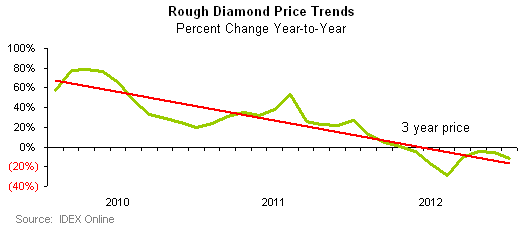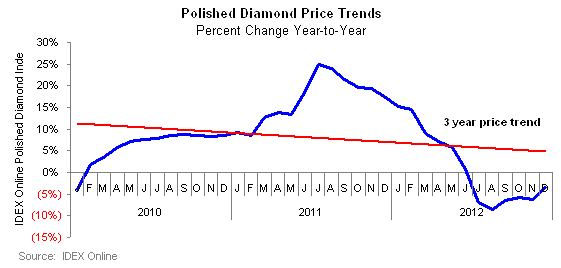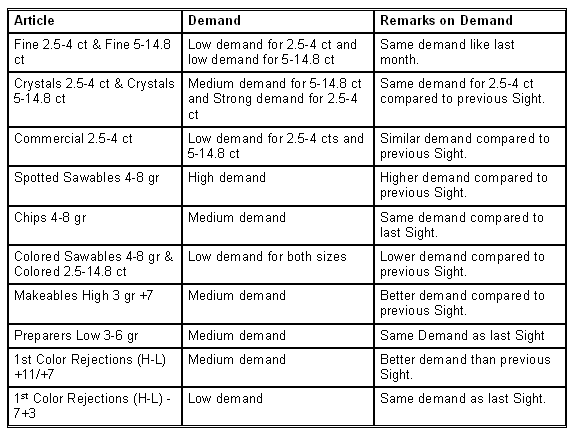Perhaps 2012 was not as much of a rollercoaster year as it was a year of evolution and change. Rough prices declined, the Oppenheimer’s cashed out, BHP Billiton found a buyer (but Rio Tinto didn’t), production was curtailed, and calls for marketing support went largely ignored by miners. An examination of the DTC price list of the past year reveals a lot of red. Time and again the leading diamond supplier to the market decreased prices in 2012. And most of the time it was just not enough, according to diamond manufacturers.
The sharpest declines took place in January and again in August. The January decline reflected lower assortments, and it was also a large Sight, setting the tone for a market with more goods than needed. The August declines followed continued pressure from Sightholders to lower prices and came after cutting their purchases to just the bare essential – either deferring up to 50 percent of allocations, or simply turning down goods.
As the graph of rough diamond prices shows (below), prices in 2012 generally declined year-over-year, after posting 20 percent to 50 percent increases in 2011 and as much as 80 percent increases in 2010 prices.

Now consider the changes to polished prices: polished prices also peaked in 2011 and fell in 2012 – but the 2011 increases were moderate compared to rough – 10 percent to 25 percent. The difference in price changes created a gap that should be taken into account when considering rough prices. As any manufacturer will attest – prices are still relatively high.

It wasn’t just a year of rough, it was a rough year in every sense of the word. Against this backdrop of a shrinking gap between rough and polished, manufacturers are facing limited turnover and liquidity issues. Much has been said about the global economic situation and growth in the BRIC countries, so there is no need to elaborate on demand in that front, but what about the supply side of the business?
[two_third]
Rough diamond supply in 2013 is expected to be inline with 2012. Both De Beers and Alrosa respectively plan to keep production levels at about 27 million carats and 34.5 million carats.
De Beers invited a group of about 15 Diamdel buyers, essentially all Indian, to apply for a DTC Sight. Without an increase in production or a decision to decrease supply of any Sightholder, that begs the question: Where will the extra goods come from?
[/two_third]
[one_third_last]
“Rough diamond supply in 2013 is expected to be inline with 2012.”
[/one_third_last]
There are two answers to this. A DTC executive told IDEX Online that supply to any possible new Sightholders will come from “new availabilities.” This stands in contrast to De Beers’ decision to not increase production.
Another insider thinks supply will come from existing lower quality “Indian goods,” scraping goods “from here and there” (read: existing Sightholders and some extra production whenever possible). Considering the limited availability, new Sightholders may get smallish Sights. The upside, besides the honor of becoming a Sightholder, is that with a foot in the door it is a lot easier to keep and increase your Sight in the future
Sight 10
Contrary to many reports, the last Sight of 2012 was a large one, estimated at about $560-$580 million, with limited ex-plan or buy backs. In the secondary market, while traders are not rushing to buy DTC boxes – still considered expensive – traders are cautiously buying some goods for stock. Call it “speculative buying” if you want, but at low volumes, and with a long-term view, this is far from the wild secondary market in early to mid-2011.
Some of the buyers are perhaps concerned that the cost to acquire the goods they manufacture may increase in price, and prefer to stock up a little bit in advance. Some DTC boxes also had better demand, such as the Spotted Sawables 4-8 gr and the Makeables High 3 gr +7 (see table of demands below).
Outlook
It would be foolish to try to predict what 2013 will look like, as everything could easily turn upside down in the coming year, all it would take is a war with Iran or a major economic crisis in China.
There are, however, a few points to consider. The recent confrontation between ABN AMRO and Arjav may have deep implications on the market. Some banks may decide to be more cautious with their lending, the Dutch Government (which owns ABN) may decide its exposure to the industry is too large, so demand for greater transparency may be a basic requirement. The past year has set the stage for more evolutionary changes.
Harry Winston did not disclose its plans about how it plans to market its goods, but becoming the fourth biggest supplier of the market, assuming the BHP deal goes though, has implications on the market.
Where is De Beers heading in the coming year seems fairly clear: final preparations for the move to Botswana, maximizing prices when possible, keeping rough production at current levels. However, how will it be affected by changes at Anglo American? As Anglo searches for a new CEO that will keep an eye on share value and returns, expect changes to trickle down to De Beers.
[two_third]
For the market to grow, a few changes are needed. First and foremost – marketing. Without getting into the question of who picks up the bill, there is no question of its importance. Compared to other discretionary income purchases, without encouraging consumer demand, interest in diamonds will fade.
Greater transparency is also needed. This will make financing, trading and consumer buying a lot easier.
[/two_third]
[one_third_last]
“Greater transparency is also needed.”
[/one_third_last]
Finally – rough prices must come down or polished prices go up. This is a message that needs to be heard by producers and jewelers alike. Without a return to a balance between rough and polished, the market will continue to be very difficult.
